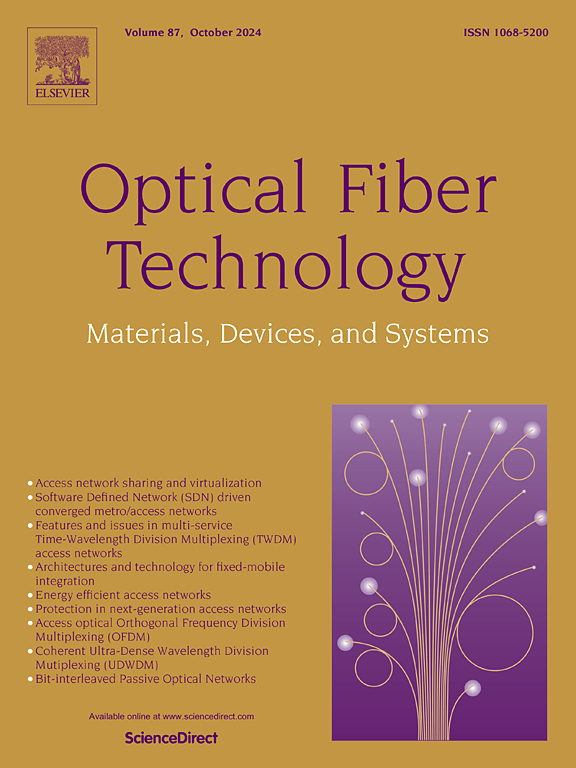2 µm mode-locked pulse generation using nickel metal-organic framework (Ni-MOF) coated arc-shaped fiber
IF 2.6
3区 计算机科学
Q2 ENGINEERING, ELECTRICAL & ELECTRONIC
引用次数: 0
Abstract
Metal-organic framework (MOF) is an emergent material that consists of metal ions and highly porous organic ligands. In this study, we demonstrate a 2 μm all-fibre mode-locked thulium/holmium-doped fiber laser (THDFL) by utilizing a nickel-based MOF (Ni-MOF) as a saturable absorber (SA) material. For the fabrication of the SA, the material was drop-casted on an arc-shaped fiber. The SA showed a 19.98 MW/cm2 saturation intensity and an exceptionally high modulation depth of 15.3 %, surpassing previously reported materials in this wavelength range. The laser output centered at 1907.66 nm with an average power reaching up to 2.057 mW. The fundamental pulse rate and width were 14.30 MHz and 1.664 ps, respectively. Consequently, the THDFL generates pulses with an energy of 175 pJ and a peak power of 105 W. Mode-locked operation proved stable as the laser was observed over 2 h and showed a signal-to-noise ratio (SNR) of about 48 dB. Notably, this work represents the first demonstration of Ni-MOF as an SA in a THDFL, opening new avenues for ultrafast fiber laser development.
2µm锁模脉冲产生采用镍金属有机框架(Ni-MOF)涂层弧形光纤
金属有机骨架(MOF)是一种由金属离子和高多孔有机配体组成的新兴材料。在这项研究中,我们利用镍基MOF (Ni-MOF)作为可饱和吸收材料,展示了一个2 μm全光纤锁模掺铥/掺钬光纤激光器(THDFL)。为了制造SA,材料被浇铸在弧形纤维上。SA显示出19.98 MW/cm2的饱和强度和15.3%的极高调制深度,超过了该波长范围内先前报道的材料。激光输出以1907.66 nm为中心,平均功率达到2.057 mW。基本脉冲速率和宽度分别为14.30 MHz和1.664 ps。因此,THDFL产生的脉冲能量为175 pJ,峰值功率为105 W。锁模工作稳定,观察时间超过2小时,信噪比约为48 dB。值得注意的是,这项工作代表了Ni-MOF在THDFL中作为SA的首次演示,为超高速光纤激光器的发展开辟了新的途径。
本文章由计算机程序翻译,如有差异,请以英文原文为准。
求助全文
约1分钟内获得全文
求助全文
来源期刊

Optical Fiber Technology
工程技术-电信学
CiteScore
4.80
自引率
11.10%
发文量
327
审稿时长
63 days
期刊介绍:
Innovations in optical fiber technology are revolutionizing world communications. Newly developed fiber amplifiers allow for direct transmission of high-speed signals over transcontinental distances without the need for electronic regeneration. Optical fibers find new applications in data processing. The impact of fiber materials, devices, and systems on communications in the coming decades will create an abundance of primary literature and the need for up-to-date reviews.
Optical Fiber Technology: Materials, Devices, and Systems is a new cutting-edge journal designed to fill a need in this rapidly evolving field for speedy publication of regular length papers. Both theoretical and experimental papers on fiber materials, devices, and system performance evaluation and measurements are eligible, with emphasis on practical applications.
 求助内容:
求助内容: 应助结果提醒方式:
应助结果提醒方式:


